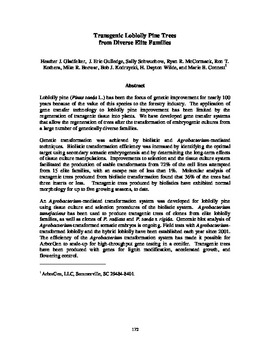| dc.contributor.author | Gladfelter, H. J. | |
| dc.contributor.author | Gulledge, J. E. | |
| dc.contributor.author | Schwuchow, S. | |
| dc.contributor.author | McCormack, R. R. | |
| dc.contributor.author | Kothera, R. T. | |
| dc.contributor.author | Becwar, M. R. | |
| dc.contributor.author | Kodrzycki, B. J. | |
| dc.contributor.author | Wilde, H. D. | |
| dc.contributor.author | Connett, M. B. | |
| dc.date.accessioned | 2016-04-25T19:36:03Z | |
| dc.date.available | 2016-04-25T19:36:03Z | |
| dc.date.issued | 2003 | |
| dc.identifier | oksd_sf27_p172.pdf | |
| dc.identifier.citation | Gladfelter, H. J., Gulledge, J. E., Schwuchow, S., McCormack, R. R., Kothera, R. T., Becwar, M. R., ... & Connett, M. B. (2003). "Transgenic Loblolly Pine Trees from Diverse Elite Families." In 27th Southern Forest Tree Improvement Conference, Stillwater, OK | |
| dc.identifier.uri | https://hdl.handle.net/11244/33685 | |
| dc.description.abstract | Loblolly pine (Pinus taeda L.) has been the focus of genetic improvement for nearly 100 years because of the value of this species to the forestry industry. The application of gene transfer technology to loblolly pine improvement has been limited by the regeneration of transgenic tissue into plants. We have developed gene transfer systems that allow the regeneration of trees after the transformation of embryogenic cultures from a large number of genetically diverse families. Genetic transformation was achieved by biolistic and Agrobacterium-mediated techniques. Biolistic transformation efficiency was increased by identifying the optimal target using secondary somatic embryogenesis and by determining the long-term effects of tissue culture manipulations. Improvements to selection and the tissue culture system facilitated the production of stable transformants from 72% of the cell lines attempted from 15 elite families, with an escape rate of less than 1%. Molecular analysis of transgenic trees produced from biolistic transformation found that 36% of the trees had three inserts or less. Transgenic trees produced by biolistics have exhibited normal morphology for up to five growing seasons, to date. An Agrobacterium-mediated transformation system was developed for loblolly pine using tissue culture and selection procedures of the biolistic system. Agrobacterium tumefaciens has been used to produce transgenic trees of clones from elite loblolly families, as well as clones of P. radiata and P. taeda x rigida. Genomic blot analysis of Agrobacterium-transformed somatic embryos is ongoing. Field tests with Agrobacterium-transformed loblolly and the hybrid loblolly have been established each year since 2001. The efficiency of the Agrobacterium transformation system has made it possible for ArborGen to scale-up for high-throughput gene testing in a conifer. Transgenic trees have been produced with genes for lignin modification, accelerated growth, and flowering control. | |
| dc.format | application/pdf | |
| dc.language | en_US | |
| dc.relation.ispartofseries | Sponsored publication . . . of the Southern Forest Tree Improvement Committee ; no. 49 | |
| dc.rights | This paper is made available through open access and the auspices of the fair use doctrine for scholarly, educational and research purposes while recognizing the publisher already offers a free online version. The OSU Library�s intent is to offer access and preserve publications involving its faculty contributions. Contact the Digital Resources and Discovery Services at lib-dls@okstate.edu or 405-744-9161 for the permission policy on the use, reproduction or distribution of this material. | |
| dc.source | Proceedings of the 27th Southern Forest Tree Improvement Conference, volume 27, 2003. Editor, Craig R. McKinley. | |
| dc.title | Transgenic Loblolly Pine Trees from Diverse Elite Families | |
| dc.type | text | |
| osu.filename | oksd_sf27_p172.pdf | |
| dc.type.genre | Conference proceedings | |
| dc.description.scopeandcontents | Papers and abstracts from the 27th Southern Forest Tree Improvement Conference held at Oklahoma State University in Stillwater, Oklahoma on June 24-27, 2003. | |
